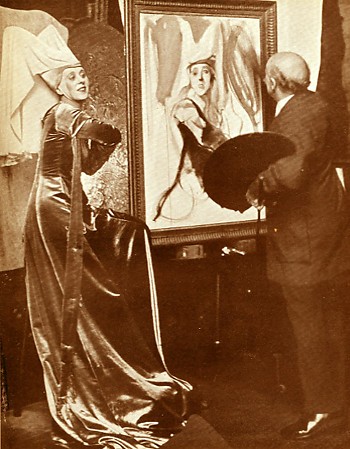|
9. Developing the Likeness
 Developing Developing
the likeness.
Q: During the rest would you explain what
you meant when you said just now that a likeness
was developed by establishing the correct relation
of light and shade?
"I cannot think of a likeness as something
apart from the general effect. There is definitely
the beginning of the likeness directly the right
beginning of the general effect is made and the
development of the likeness goes on steadily as
the general effect is amplified and made more
complete. At first, as I have already told you,
I deal with the larger planes only, hut as I proceed
I occupy myself more and more with the smaller
planes and with those lesser subtleties by which
what I would call the intimacy of the likeness
is attained. But, of course, all through I aim
at the correct relationship of values because
without that a real likeness is impossible."
Q: It still seems strange to me that you can
get a likeness in a portrait without a preparatory
drawing on the canvas, something plainly stated
that you can build upon—most artists seem
to regard a drawing as an indispensable foundation.
"I do not believe in doing a drawing first
and then painting over it. That way there is a
danger of losing one's freedom to take in the
general effect and of becoming a slave to one's
own doings. I consider that an artist should acquire
such a thorough understanding of drawing that
he can use it instinctively in his work without
thinking of it as being separate from painting—but I see my sitter is ready again so I
must get back to my picture."
10. Unity of Effect

Head and
accessories
receive almost
simultaneous
attention to achieve
unity of effect.
Q: Well, what is the next stage?
"Hitherto I have been concerned mainly with
the head, as you have, I expect, noticed. Now,
before I carry that further, I want to bring the
rest of the picture to the same stage of harmonious
unity throughout. This is necessary to enable
me to judge how much more development the head
will require to have the strength and significance
of effect at which I am aiming. But remember this,
that no two heads can be treated in exactly the
same way and that in each one the character and
type must to a great extent dictate the manner
of dealing with it which should be adopted. A
head with strongly marked features, for instance,
does not demand such detailed treatment as one
with less definite forms. It can be presented
much more broadly and simply because its characteristics
are more immediately apparent."
Q: For a while, then, you will leave the head
as it is?"
"Yes, before I finish it I must attend to
the surroundings and give them, or at all events
the more important part of them, their full strength.
I can tell then what degree of force should be
added to the head to make it, as it should be,
the dominant fact in the picture. Even when I
am not actually working on the head, I am still
thinking about it and the relation which must
be established between it and the accessories
among which it is set."
|